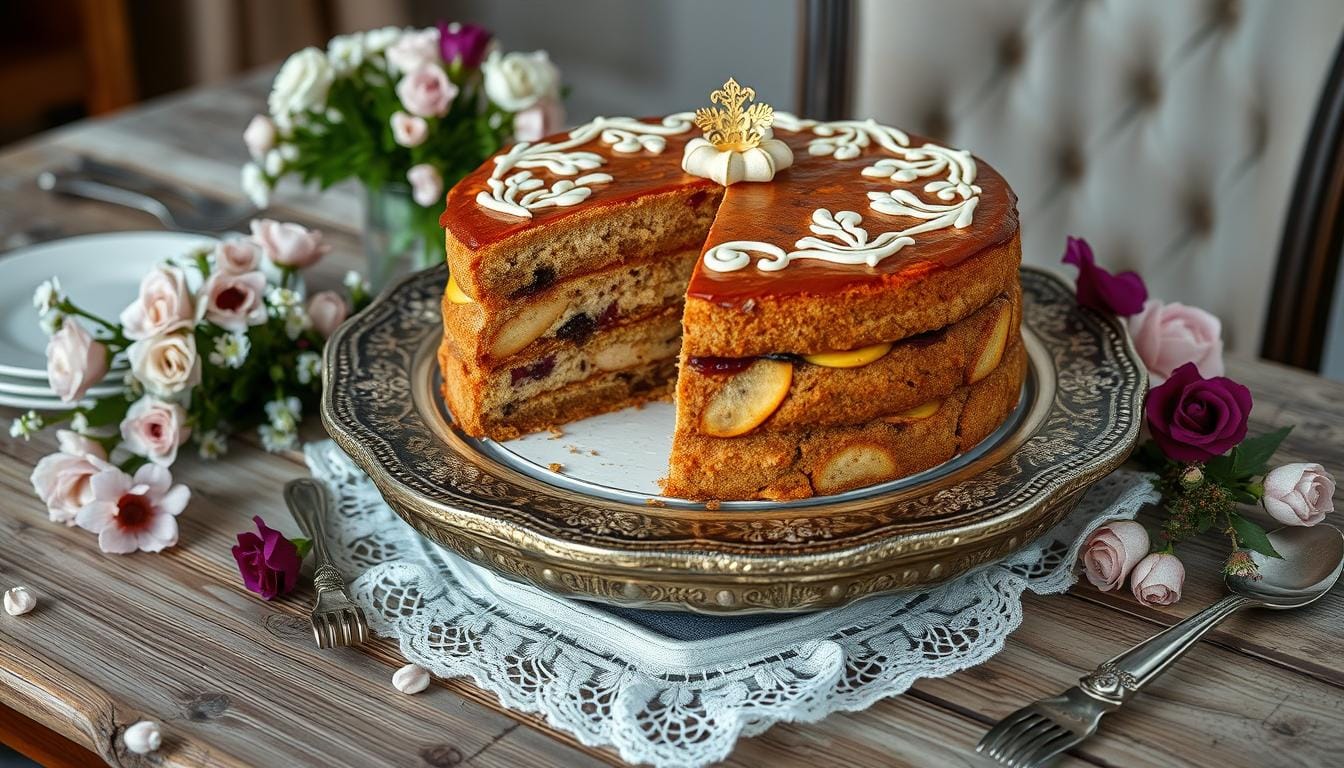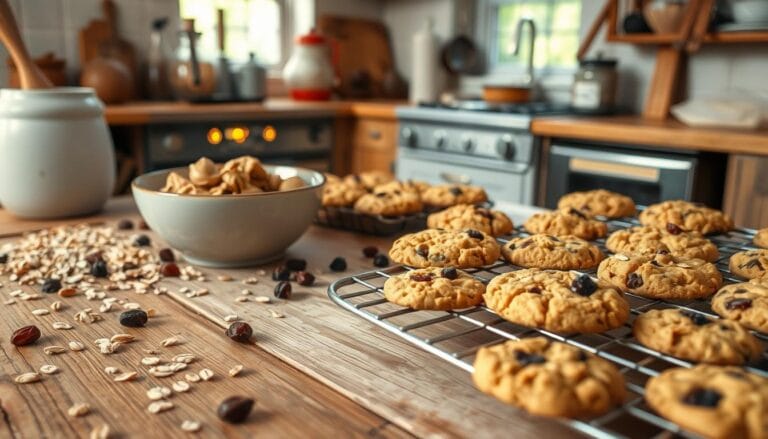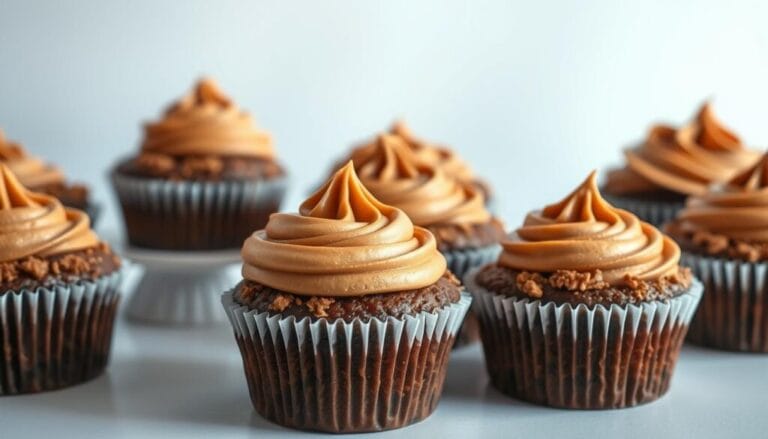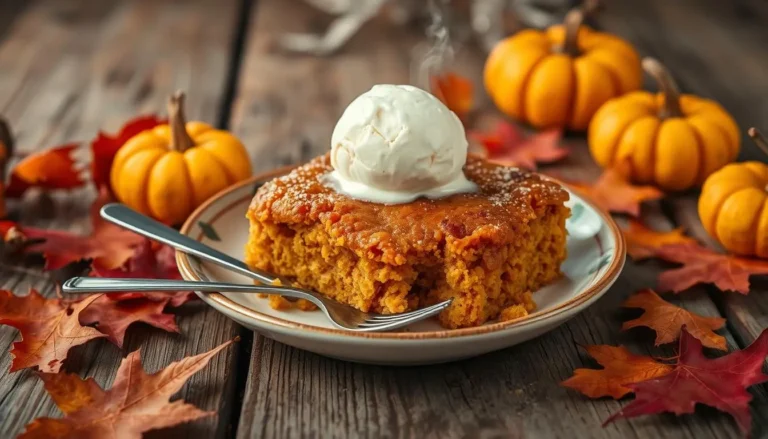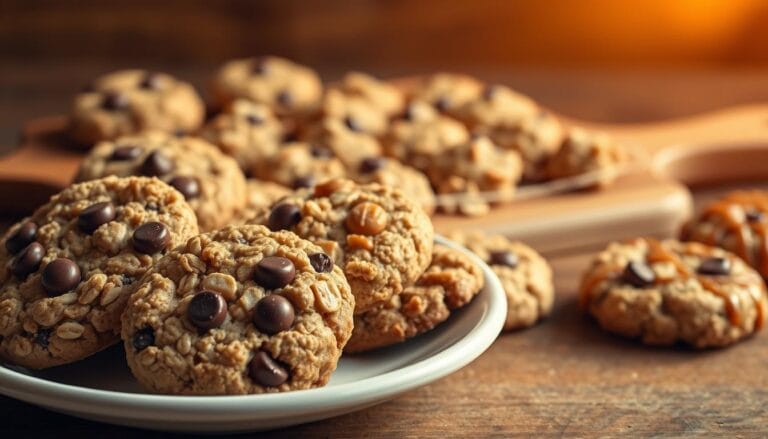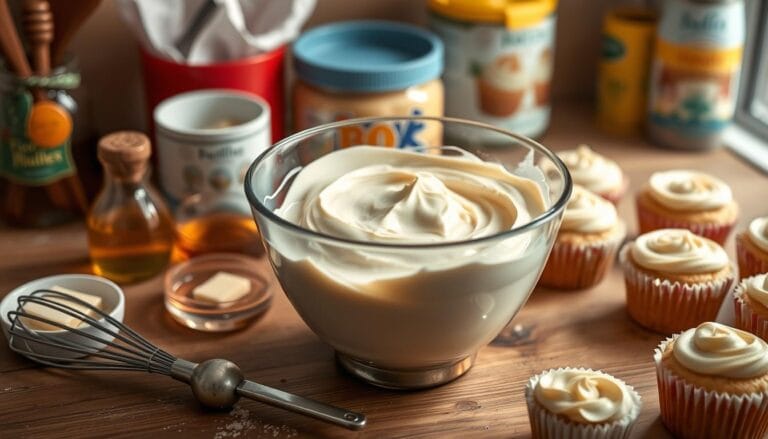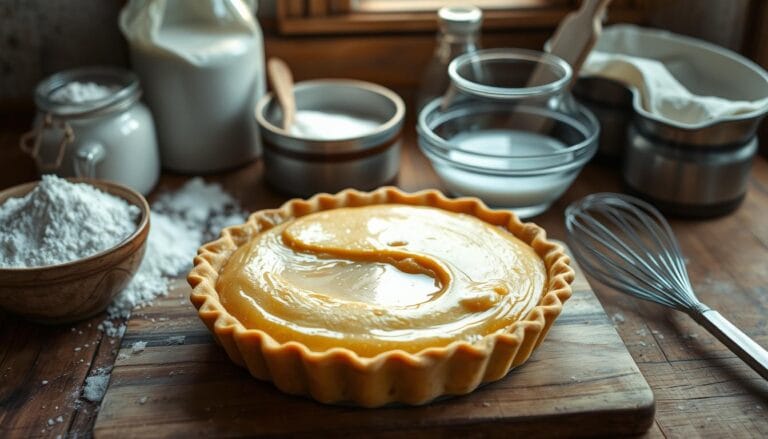18th Century Queen’s Cake Recipe: A Timeless Royal Classic
Exploring traditional recipes leads to the 18th century queen’s cake recipe. This treat has been around for over 90 years, matching the Queen of England’s 90th birthday. It has a rich history and has evolved over time, becoming a favorite in many homes.
Table of Contents
The first Queen’s Cake recipe was published by Robert Smith in 1724. Since then, it has seen many changes, like the addition of orange flower water and ground mace. Baking this cake is a fun way to taste history, whether you love history or food.
The 18th century queen’s cake is a unique and tasty treat that has been loved for centuries. It’s made with butter, sugar, eggs, and currants, showing its traditional roots. By using soft butter, raw cane sugar, and flour, you can make a real 18th century queen’s cake.
Key Takeaways
- The 18th century queen’s cake recipe has a rich history dating back to 1724.
- The recipe has undergone many variations over time, including the addition of ingredients like orange flower water and ground mace.
- To create an authentic 18th century queen’s cake, you’ll need ingredients like soft butter, raw cane sugar, and flour.
- The cake is a classic example of a traditional recipe, with a combination of butter, sugar, eggs, and currants.
- By following the original recipe, you can create a truly delicious and authentic 18th century queen’s cake.
- The 18th century queen’s cake recipe is a great way to experience a taste of the past and explore the world of traditional recipes.
The Royal Origins of Queen’s Cake
Exploring culinary history reveals Queen’s Cake’s royal roots. This traditional dessert has been a favorite in British royal treats for centuries. Its first recipe was in Robert Smith’s “Court Cookery” in 1724, using currants, mace, and orange flower water.
Queen’s Cake is linked to royal events and special times, marking about 250 years of culinary history. To make a real Queen’s Cake, you need flour, butter, sugar, and currants. Here’s what you’ll need:
- 125g of soft butter
- 125g of caster sugar
- 150g of plain flour
- 125g of dried currants
These ingredients, mixed with traditional baking, make a unique and tasty royal treat. As you learn about Queen’s Cake, you’ll see its importance in culinary history and its lasting appeal in British culture.
Queen’s Cake, with its deep culinary history and royal ties, is sure to wow. Whether you love history or food, trying this traditional dessert is a must. So, treat yourself to a slice of Queen’s Cake and enjoy the royal treats that have delighted people for centuries.
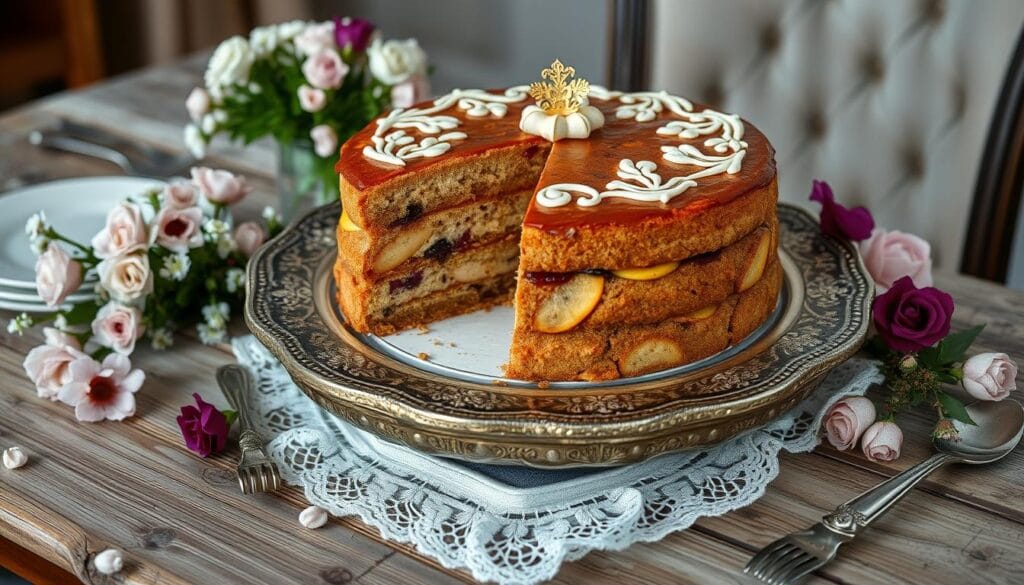
What Makes an Authentic 18th Century Queen’s Cake Recipe Special
In historic cooking, the Queen’s cake stands out. It’s a beloved English dessert from the 18th century. To make it, you need butter, sugar, eggs, and dried currants, common in historic cooking.
The queen’s cake recipe is loved for its taste and texture. It’s made by mixing ingredients and baking in a heart-shaped pan. This creates a moist cake that’s great with tea.
Here are the main ingredients in the queen’s cake recipe:
- 125g of soft butter
- 125g of caster sugar
- 2 large free-range eggs
- 150g of plain flour
- 125g of dried currants
These ingredients make a dessert that’s both unique and delicious. By using an authenticqueen’s cake recipe and traditionalhistoric cooking methods, you’ll impress everyone with your dessert.
Traditional Ingredients and Their Historical Significance
Exploring the 18th century queen’s cake recipe reveals the traditional ingredients used. The original recipe, from “Court Cookery” by Robert Smith, included currants, mace, and orange flower water. These ingredients added unique flavors and held cultural and historical value.
Key Spices and Flavorings
The 18th century queen’s cake recipe highlights the importance of spices and flavorings. Key ingredients include:
- Currants, which added natural sweetness and texture to the cake
- Mace, a spice made from the outer covering of the nutmeg seed, which added a warm, aromatic flavor
- Orange flower water, which added a delicate, citrusy flavor to the cake
Today, these ingredients are still used in many 18th century queen’s cake recipes. Their historical significance shows the lasting appeal of this dessert. Using these ingredients lets you make an authentic traditional recipe that takes you back in time.
To better understand the traditional ingredients of the 18th century queen’s cake recipe, consider the following table:
| Ingredient | Historical Significance |
|---|---|
| Currants | Natural sweetness and texture |
| Mace | Warm, aromatic flavor |
| Orange flower water | Delicate, citrusy flavor |
By exploring the traditional ingredients and their historical significance, you can appreciate the 18th century queen’s cake recipe more. It shows the lasting impact of this dessert in traditional recipes.
Kitchen Tools and Equipment Needed
To explore 18th century Queen’s cake, knowing the cultural significance of kitchen tools is key. The right tools are essential for an authentic experience. Preparing royal treats like Queen’s cake requires the right equipment.
In the 18th century, bakers used simple yet effective tools. You’ll need a mortar and pestle, a mixing bowl, and a baking sheet. These tools were crucial for making Queen’s cake. As you prepare, you’re stepping into culinary history.
Here are some key tools and equipment you’ll need:
- Mortar and pestle for grinding spices and nuts
- Mixing bowl for combining ingredients
- Baking sheet for baking the cake
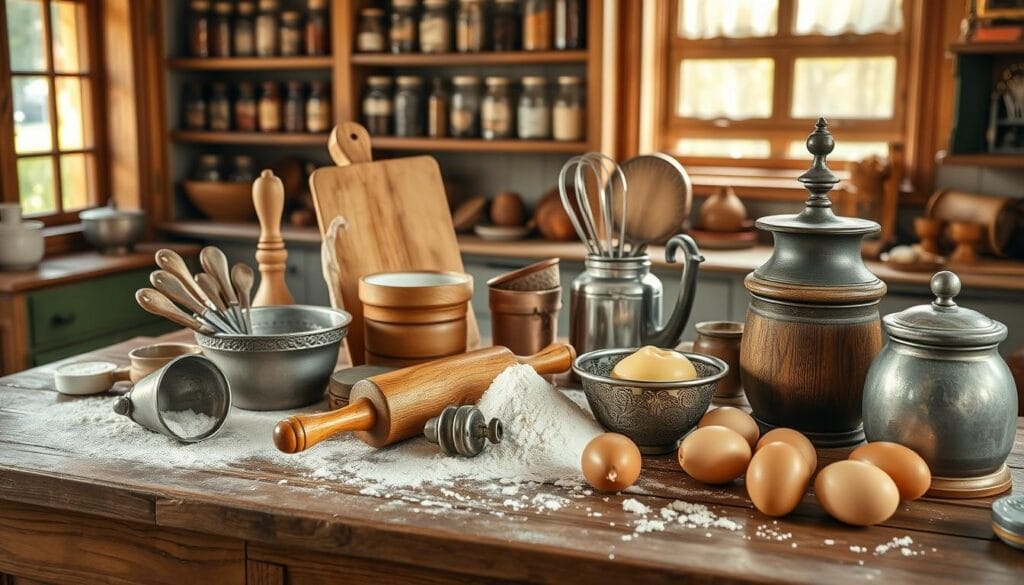
Using these traditional tools, you’ll make an authentic 18th century Queen’s cake. It’s a great way to connect with history and enjoy a tasty royal treat.
Step-by-Step 18th Century Queen’s Cake Recipe
To make an authentic 18th century queen’s cake, you need to prepare your workspace. Then, mix the batter and use traditional baking methods. This historic cooking technique requires attention to detail and specific ingredients like all-purpose flour, sugar, and currants.
Robert Smith’s book shows the original Queen Cakes recipe from 1725. It uses a 1:1:1:1 ratio for the main ingredients. Begin by preheating your oven to 325°F.Prepare two 12-cup muffin pans. Mix together 1 cup of all-purpose flour, 1/2 cup of sugar, and 1/4 teaspoon of salt.
The recipe calls for 1/2 cup of butter, 2 eggs, and 1/4 cup of currants. You can add optional ingredients like 2 tablespoons of rosewater or orange flower water, or 1 teaspoon of vanilla extract. After mixing all the ingredients, pour the batter into the muffin pans. Bake for 15 to 20 minutes.
- 1 cup of all-purpose flour
- 1/2 cup of sugar
- 1/4 teaspoon of salt
- 1/2 cup of butter
- 2 eggs
- 1/4 cup of currants
- Optional: 2 tablespoons of rosewater or orange flower water, or 1 teaspoon of vanilla extract
By following these steps and using these ingredients, you can make an authentic 18th century queen’s cake. This historic cooking technique is a great way to experience the flavors and traditions of the past. It’s a fun and rewarding project to undertake.
Modern Adaptations for Today’s Kitchen
When making an 18th century queen’s cake, you can follow traditional recipes but with a twist. You can cut down on sugar to make it less sweet. This change makes the cake more to your liking.
In today’s kitchen, you can use new ingredients and methods. This makes the 18th century queen’s cake recipe easier to make. Here are some ways to adapt it:
- Using digital scales for precise measurements
- Substituting ingredients with gluten-free or low-sugar alternatives
- Adjusting the baking temperature and time to suit your oven
These modern changes let you enjoy the cake’s traditional taste. But you can also make it fit your dietary needs. Traditional recipes are a good base. Feel free to try new things and make the cake your own.
Common Challenges and Troubleshooting
Exploring 18th century Queen’s Cake can lead to some common issues. Knowing its culinary history helps solve these problems. The main challenge is getting the right texture and consistency. This depends on the quality of ingredients and the baking temperature.
Robert Smith’s book highlights the importance of adjusting the baking temperature. For an 18th-century Queen’s Cake, use 350°F (180°C) and bake for 22-26 minutes. A digital thermometer and timer are key to precise baking.
Storage Solutions
After baking your Queen’s Cake, proper storage is crucial. Here are some tips:
- Keep the cake in a sealed container at room temperature for up to 3 days.
- Securely wrap the cake in plastic wrap or aluminum foil and freeze it for up to 2 months.
- Consider using a cake keeper or a glass dome to maintain humidity and keep the cake fresh.
By tackling common challenges, you can improve your baking. This will help you make an authentic 18th century Queen’s Cake. It’s a treat that showcases the culinary history and royal connections of the time.
Keep experimenting with this recipe, sticking to the original ingredients and methods. This will help you create a genuine Queen’s Cake, worthy of royalty.
| Ingredient | Quantity | Percentage of Total Weight |
|---|---|---|
| Flour | 1 cup (120g) | 45% |
| Sugar | ½ cup (100g) | 38% |
| Butter | ½ cup (115g) | 43% |
Serving Suggestions and Historical Presentation
To serve an 18th century Queen’s cake, aim to take your guests back in time. Pair it with tea, a favorite drink then. Add icing and nonpareils for a touch of history.
In historic cooking, presentation mattered a lot. So, focus on the details when serving your Queen’s cake. Eliza Leslie’s book offers great insights into 18th century cooking.
Traditional Accompaniments
Here are some traditional pairings for Queen’s cake:
- Tea, a staple in 18th century England
- Fresh fruits, like strawberries or raspberries
- Whipped cream or icing, for sweetness
Decorative Elements
For a decorative touch, consider:
- Icing, a favorite decoration then
- Nonpareils, small sprinkles for festivity
- Fresh flowers, like roses or lavender, for beauty and scent
With these accompaniments and decorations, your guests will love the experience. Whether at a dinner party or special event, your Queen’s cake will impress. So, be creative and enjoy the rich flavors and history of queen’s cake recipe and historic cooking.
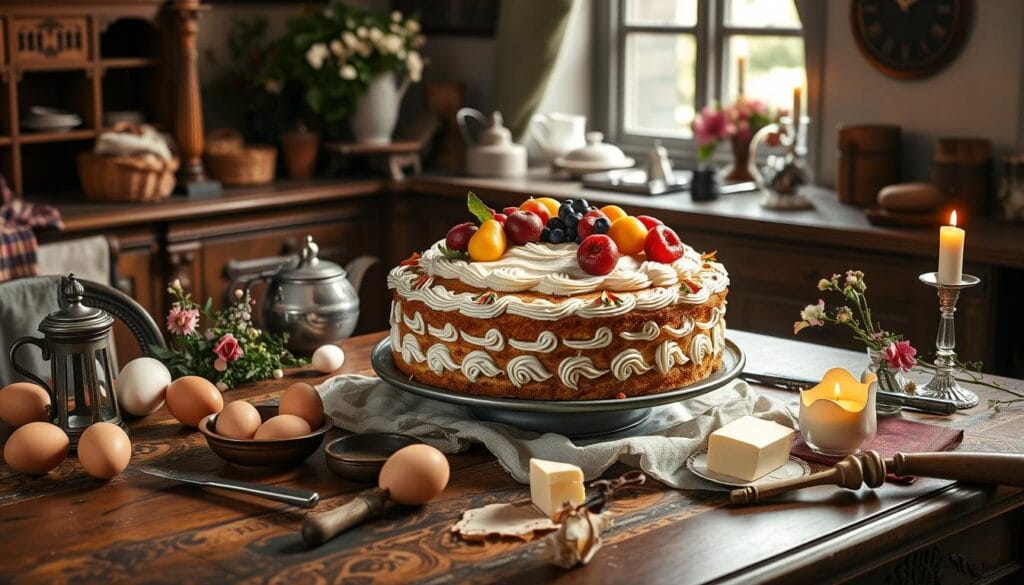
| Traditional Accompaniments | Decorative Elements |
|---|---|
| Tea | Icing |
| Fresh fruits | Nonpareils |
| Whipped cream | Fresh flowers |
Variations and Regional Differences
Exploring the 18th century queen’s cake recipe reveals many regional differences and traditional recipes. Queen Cakes were a big hit in English bakeries. Each region put its own special touch on the original recipe.
Some notable variations include using candied orange peel and citron, which were favorites in the 18th century. These ingredients gave the cake a unique taste and texture. It was a favorite among the aristocracy.
Here are some regional differences and variations you might find interesting:
- Heart cakes, a variation of queen cakes, were baked in heart-shaped tins. They were often served at Valentine’s Day celebrations.
- Traditional recipes from the 18th century used a ratio of ½ cup of butter to ½ cup of sugar. Two eggs were used to give the cake structure.
- Modern variations of queen cakes include ingredients like dried cranberries, cherries, or chocolate. These show how the original recipe can be adapted.
By looking into these variations and regional differences, you’ll understand the 18th century queen’s cake recipe better. Whether you love history or baking, you’ll find this dessert’s rich heritage and cultural significance fascinating.
Tips for Perfect Results Every Time
Baking an 18th century Queen’s cake is all about the culinary history behind it. To get it right every time, focus on temperature, ingredients, and timing. These steps will help you make a delicious, authentic Queen’s cake that will wow everyone.
Temperature control is crucial when baking a Queen’s cake. The ideal cooking temperature is 375°F (190°C). Keeping this temperature ensures your cake turns out perfectly. Also, using top-notch ingredients like fresh eggs and real butter will make your cake taste amazing, turning it into a true royal treat.
Here are some more tips to remember:
- Use room temperature ingredients for a smooth batter
- Avoid overmixing to prevent a dense cake
- Let the batter rest before baking for a lighter cake
By following these tips and understanding the importance of temperature, ingredients, and timing, you’ll make a perfect 18th century Queen’s cake. It will be filled with culinary history and rich flavor, making it a great royal treat for any event.
Conclusion: Preserving Culinary Heritage Through Baking
As we wrap up our exploration of 18th century Queen’s Cake, we see how vital it is to keep our culinary heritage alive. This dessert, filled with royal history and cultural importance, is a tradition we must hold dear and share with future generations.
By baking an authentic 18th century Queen’s Cake, you indulge your taste buds in a piece of history. You also help keep our culinary legacy alive. The mix of spices, the rich texture, and the traditional methods used in making it offer a unique taste experience. It takes us back to the lavish salons of 18th century aristocracy.
Historic cooking lets us honor the past and appreciate the growth of our culinary traditions. Learning about Queen’s Cake’s origins and its role in society shows us the skill and creativity of our ancestors. Despite challenges like ingredient shortages and economic struggles, they created culinary wonders.
Starting your Queen’s Cake baking adventure is a way to celebrate the lasting impact of culinary heritage. By keeping these recipes alive and sharing them, you add to our shared culinary history. This ensures that the flavors and stories of the past will continue to excite and inspire future generations.
FAQ
What is 18th century Queen’s cake?
18th century Queen’s cake recipe is a traditional English dessert. It has a rich history tied to the British monarchy. This treat was loved by the upper classes during the Georgian era.
What are the origins of the Queen’s cake recipe?
The Queen’s cake recipe has royal roots, connected to the British monarchy. It evolved through the Georgian era. It was important in 18th century society.
What makes an authentic 18th century Queen’s cake recipe special?
An authentic 18th century Queen’s cake recipe is special. It uses unique ingredients and cooking techniques. These add to its distinctive flavor and texture.
What were the traditional ingredients used in 18th century Queen’s cake?
Traditional Queen’s cake included key spices and flavorings. It also used period-appropriate substitutions and measurements. These were crucial for its authentic taste.
What kitchen tools and equipment were used to make 18th century Queen’s cake?
Making 18th century Queen’s cake used historical kitchen tools and equipment. These tools hold their own significance in culinary heritage.
How do you make an authentic 18th century Queen’s cake?
To make an authentic 18th century Queen’s cake, follow a step-by-step guide. It covers workspace preparation, batter mixing, and traditional baking methods.
How can you adapt the 18th century Queen’s cake recipe for modern kitchens?
You can adapt the 18th century Queen’s cake recipe for modern kitchens. Stay true to its historical roots but use today’s ingredients and tools.
What are some common challenges and troubleshooting tips for making 18th century Queen’s cake?
Making 18th century Queen’s cake can face challenges like texture and consistency issues. There are tips for adjusting baking temperature and storage. These ensure a perfect cake every time.
How should 18th century Queen’s cake be served and presented?
Serve 18th century Queen’s cake traditionally. Include accompanying elements and decorative touches. These add to the overall experience and authenticity of this beloved dessert.
Are there any variations or regional differences in 18th century Queen’s cake recipes?
Yes, 18th century Queen’s cake recipes vary across England. Each region has unique ingredients and cooking techniques. These contribute to the dessert’s diversity and richness.
What are the tips for achieving perfect results when making 18th century Queen’s cake?
For perfect results, control temperature and select ingredients carefully. Follow precise timing guidelines. These tips help you bake an authentic and delicious 18th century Queen’s cake.
There are no reviews yet. Be the first one to write one.
